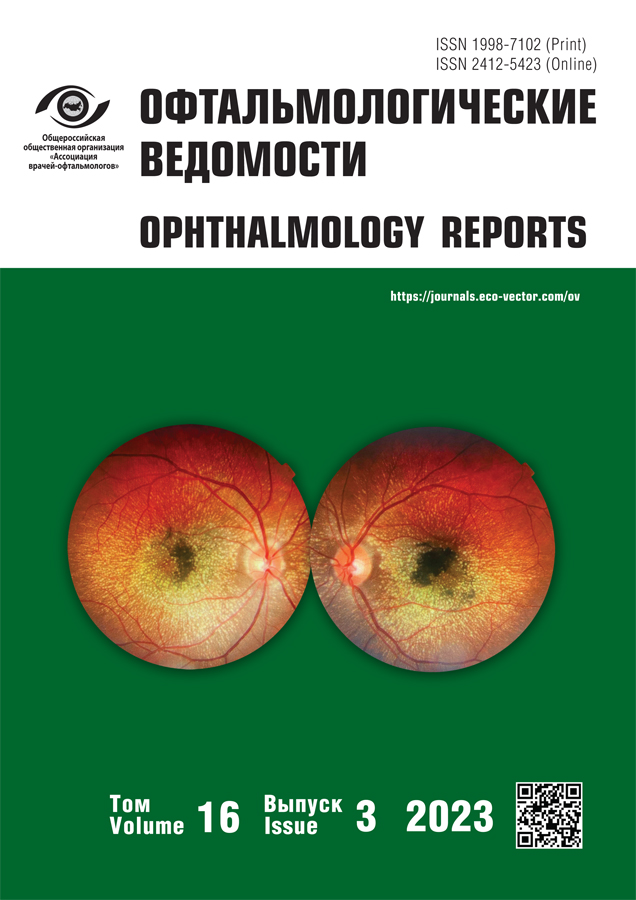Phacoemulsification with IOL implantation at a critical level of corneal endothelial cells
- Authors: Loskutov I.A.1, Fedorova A.I.1
-
Affiliations:
- Moscow Regional Research and Clinical Institute
- Issue: Vol 16, No 3 (2023)
- Pages: 63-69
- Section: Experimental trials
- Submitted: 31.07.2023
- Accepted: 06.09.2023
- Published: 17.10.2023
- URL: https://journals.eco-vector.com/ov/article/view/567921
- DOI: https://doi.org/10.17816/OV567921
- ID: 567921
Cite item
Abstract
BACKGROUND: Cataract phacoemulsification is one of the most frequently performed surgical procedures, and a decrease in the corneal endothelial cell density (ECD) is the main postoperative complication leading to visual impairment. The average cell loss after phacoemulsification is 4.01–12.94% within a year, and within 2 months — 5.2–9.1%. The use of viscoelastics helps to reduce this loss, but it is impossible to completely prevent it.
AIM: Сomparison of ECD in the pre- and postoperative period of phacoemulsification using viscoelastic of different percentages at a critical level of corneal endothelial cells.
MATERIALS AND METHODS: The study included 60 eyes with emmetropic refraction: in the first group: 30 eyes with initial cataract and low ECD level (1694/1218 cells/mm2), an apyrogenic moderately cohesive viscoelastic 1.6% sodium hyaluronate solution (Kogevisk®, Solopharm) was used, in the second group: 30 eyes with mature cataract and ECD level (1646/1183 cells/mm2) an apyrogenic, highly purified viscoelastic was used, consisting of medium-molecular fractions of chondroitin sodium sulfate 4% and sodium hyaluronate 3% (Adhevisk®, Solopharm). Before surgery and a month after surgery, patients were tested for uncorrected visual acuity in the distance, ECD measurements, and intraocular pressure measurement.
RESULTS: In phacoemulsification with IOL implantation, the use of viscoelastics of different percentages shows that the condition of the cornea remained stable a month after surgery. Postoperative ECD loss in all clinical cases, regardless of the stage of cataract, was less than 3%.
CONCLUSIONS: Viscoelastics allow to solve the tasks set: in the case of cohesive — maintaining the depth of the anterior chamber and the width of the pupil, adhesive — protecting the corneal endothelium, good visualization. Rational consistent use of adhesive and cohesive components facilitates basic manipulations during phacoemulsification and IOL implantation. To do this, it is necessary to correctly use and select viscoelastic for a particular operation based on the number of endothelial cells.
Full Text
About the authors
Igor A. Loskutov
Moscow Regional Research and Clinical Institute
Email: zai4en@mail.ru
ORCID iD: 0000-0003-0057-3338
SPIN-code: 5845-6058
Professor, Ophthalmologist of the Moscow Region, Head of the Ophthalmological Department
Russian Federation, MoscowAnastasia I. Fedorova
Moscow Regional Research and Clinical Institute
Author for correspondence.
Email: zai4en@mail.ru
ORCID iD: 0009-0008-7670-2910
Resident Doctor
Russian Federation, MoscowReferences
- Bourne RRA, Minassian DC, Dart JKG, et al. Effect of cataract surgery on the corneal endothelium: Modern phacoemulsification compared with extracapsular cataract surgery. Ophthalmology. 2004;111(4):679–685. doi: 10.1016/j.ophtha.2003.07.015
- Traish AS, Colby KA. Approaching cataract surgery in patients with Fuchs’ endothelial dystrophy. Int Ophthalmol Clin. 2010;50(1): 1–11. doi: 10.1097/IIO.0b013e3181c5728f
- Hayashi K, Yoshida M, Manabe S-I, Hirata A. Cataract surgery in eyes with low corneal endothelial cell density. J Cataract Refract Surg. 2011;37(8):1419–1425. doi: 10.1016/j.jcrs.2011.02.025
- Yamazoe K, Yamaguchi T, Hotta K, et al. Outcomes of cataract surgery in eyes with a low corneal endothelial cell density. J Cataract Refract Surg. 2011;37(12):2130–2136. doi: 10.1016/j.jcrs.2011.05.039
- Mencucci R, Ponchietti C, Virgili G, et al. Corneal endothelial damage after cataract surgery: Microincision versus standard technique. J Cataract Refract Surg. 2006;32(8):1351–1354. doi: 10.1016/j.jcrs.2006.02.070
- Baradaran-Rafii A, Rahmati-Kamel M, Eslani M, et al. Effect of hydrodynamic parameters on corneal endothelial cell loss after phacoemulsification. J Cataract Refract Surg. 2009;35(4):732–737. doi: 10.1016/j.jcrs.2008.12.017
- Loskutov IA, Mamedov ZI, Fedorova AI, Tigranyan AK. Metodicheskoe posobie. Optimal’nyi vybor viskoehlastika v praktike oftal’mologa. Saint Petersburg: Groteks, 2023. P. 5–21. (In Russ.)
- Mahdy MAS, Eid MZ, Mohammed MA-B, et al. Relationship between endothelial cell loss and microcoaxial phacoemulsification parameters in noncomplicated cataract surgery. Clin Ophthalmol. 2012;6:503–510. doi: 10.2147/OPTH.S29865
- Lee K-M, Kwon H-G, Joo C-K. Microcoaxial cataract surgery outcomes: Comparison of 1.8 mm system and 2.2 mm system. J Cataract Refract Surg. 2009;35(5):874–880. doi: 10.1016/j.jcrs.2008.12.031
- Dewan T, Malik PK, Kumari R. Comparison of effective phacoemulsification time and corneal endothelial cell loss using 2 ultrasound frequencies. J Cataract Refract Surg. 2019;45(9):1285–1293. doi: 10.1016/j.jcrs.2019.04.015
- Loskoutov IA, Korneeva AV. The influence of new ophthalmic viscoelastic devices on the level of intraocular pressure after phacoemulsification. National Journal glaucoma. 2020;19(2):31–38. (In Russ.) doi: 10.25700/NJG.2020.02.04
Supplementary files










